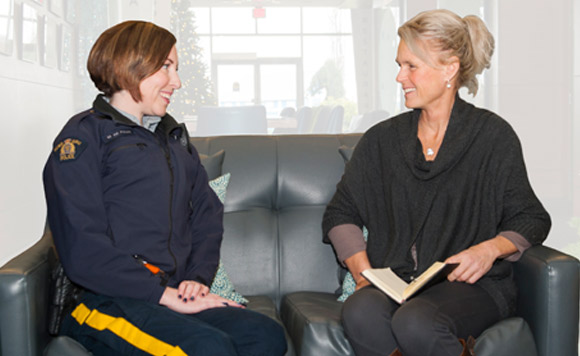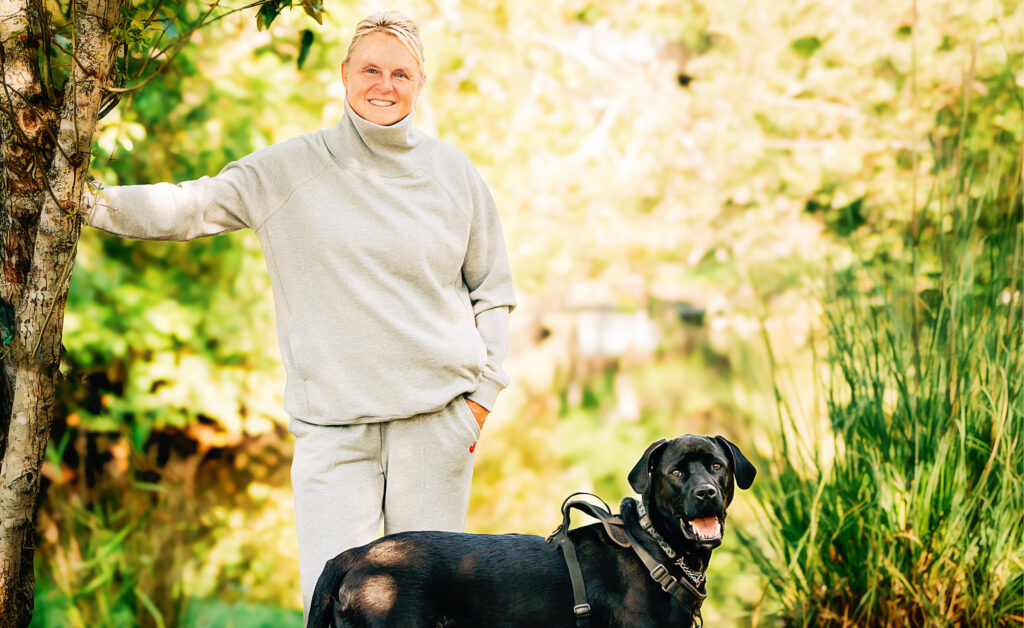Owner / Publisher Sue Hodgson Chats With CST. Meighan de Pass, Sidney and North Saanich Community Policing Officer
You have just recently taken on the role of Sidney and North Saanich Community Policing Officer, taking over from Constable George Phipps. What are the priorities of this position, and what key areas will be focused on for the two communities?
As a personal priority, it’s important to me that I properly identify the needs of my community groups: our merchants, our residents, the schools and the seniors of our communities. Each of these groups have individual needs which can be addressed in a variety of ways. I am seeking feedback and suggestions from the communities, supported by my position as co-chair of the Sidney/North Saanich Community Consultative Group. We are starting “Coffee with a Cop” in January, a relationship-building event where the public can speak with police in a casual setting.
Our detachment priorities for our Community Policing Section include education and prevention programs covering topics such as BlockWatch, Citizens on Patrol, Frauds, Scams, Internet Safety, Illicit Drug and Substance Education and promoting pedestrian and cycling safety. We also work with our business community to assist in Loss Prevention strategies. To assist us in meeting these priorities we have Auxiliary members and volunteers. We are also looking to increase our RCMP Volunteer base to support our local programs, and also to support the roll out of some new ones. We are having a Volunteer Information Session on January 29 at the SHOAL Centre.
How will you work to keep residents safe, including our youth
at the local schools?
Crime Prevention is a cornerstone of Community Policing, which serves as an effective method of education therefore increasing the safety of residents and youth. The WITS and DARE programs which are delivered to our elementary school students are designed to prepare kids for the challenges and pressures they will be exposed to. I will be teaching DARE and conducting training for our community groups on personal safety such as Fraud Prevention, Internet Safety, and Personal Safety etc. As a liaison officer, I aim to develop relationships with anyone I meet, hopefully letting that person know that their local officers care about them and are here for them regardless of the situation.
We work with our communities on educational initiatives, addressing concerns of our residents such as distracted driving, panhandling, theft from automobiles etc. We also utilize Crime Statistics to plan our patrols and operational enforcement in areas where they are most needed. My role in this is to roll out these great programs and facilitate relationships in the community which allow for a more effective flow of information in both directions. The more information we receive from the public, the better we can serve them.
Are older people disproportionately affected by crime?
Our senior population is no more likely to be affected by crime rates than any other demographic. The exception to this statement is fraud-related or trust-based schemes. Criminals tend to target their scams and trickery based on their likelihood of success. Our senior population is often targeted due to their tendency to trust and accept people at their word.
The less scrupulous in society capitalize on this. It’s important to also note that this may not always be perpetuated by a stranger on the phone or via email: it may be a person known to the victim or a family member. Care workers, family members, close friends and spouses are in excellent positions to be aware and prevent these incidents by noting changes in financial habits or state of mind.
Is cyber-crime really a threat to seniors, or is it exaggerated by the media?
The media is not exaggerating it: this is a real and consistent threat to seniors that is constantly evolving and adapting to security measures. There are safeguards in place to assist in preventing these incidents but it is important to take steps to ensure your own safety.
What are some ways residents can protect themselves from fraud?
Some tips that we recommend are as follows:
• Never give out financial or personal information.
• Never advance funds up front.
• Do not feel pressured by statements such as “Last Opportunity,” “Only good for today” etc.
• Have a lawyer or family member review all contracts before signing.
• If you are suspicious, trust your instincts and call the police.
• Do not allow a family member or friend to pressure you into giving them your cash, debit or credit cards.
What is the biggest threat seniors should be aware of, and what is a simple safety checklist you can offer them?
The biggest threats to seniors are online/telephone frauds and basic safety when out and about. In relation to the fraud safety I recommend the above tips as a starter for all seniors looking to safeguard themselves. There are many ways to take steps toward becoming safer and more prepared. I encourage our seniors to take advantage of reflectors (available at our detachment) and high visibility clothing while outside, especially at this time of the year. The rain and cloudiness can make visibility difficult for drivers and pedestrians alike. Use the crosswalks, make eye contact and remember that not all drivers will see you immediately. Having the right of way doesn’t prevent injury.
Our Crime Prevention team has put together some fantastic resources designed for our senior community. They are called Ageless Wisdom and speak to the three main categories pertinent to seniors: Frauds, Personal Safety and Abuse. I have ordered these and placed them at our detachment and the SHOAL Centre. I also present Seniors Safety presentations, which can be tailored to specific concerns or more general. I am available to meet with any group who wishes.
Can you tell us about a couple of unique calls that you remember receiving while serving the community?
My favourite is from last summer. One of our volunteers was on patrol when he was shot by a BB gun. The BB grazed his head and luckily he was OK. The investigation determined that the BB was shot by some local youth who were shooting signs and had no intention of harming anyone. I referred this to Restorative Justice where the youths and the victim resolved this informally. The relationship that developed between the BB gun owner youth and the victim was so positive that a year later, the victim took the young man out fishing for salmon with him.
Another call that has remained with me was when a local resident called to report a suspicious door-to-door sales person. Someone was selling a service which was vastly overpriced and unnecessary. Thankfully, the caller’s young neighbour was a construction worker who walked over and intervened, thus preventing our caller from being scammed.




